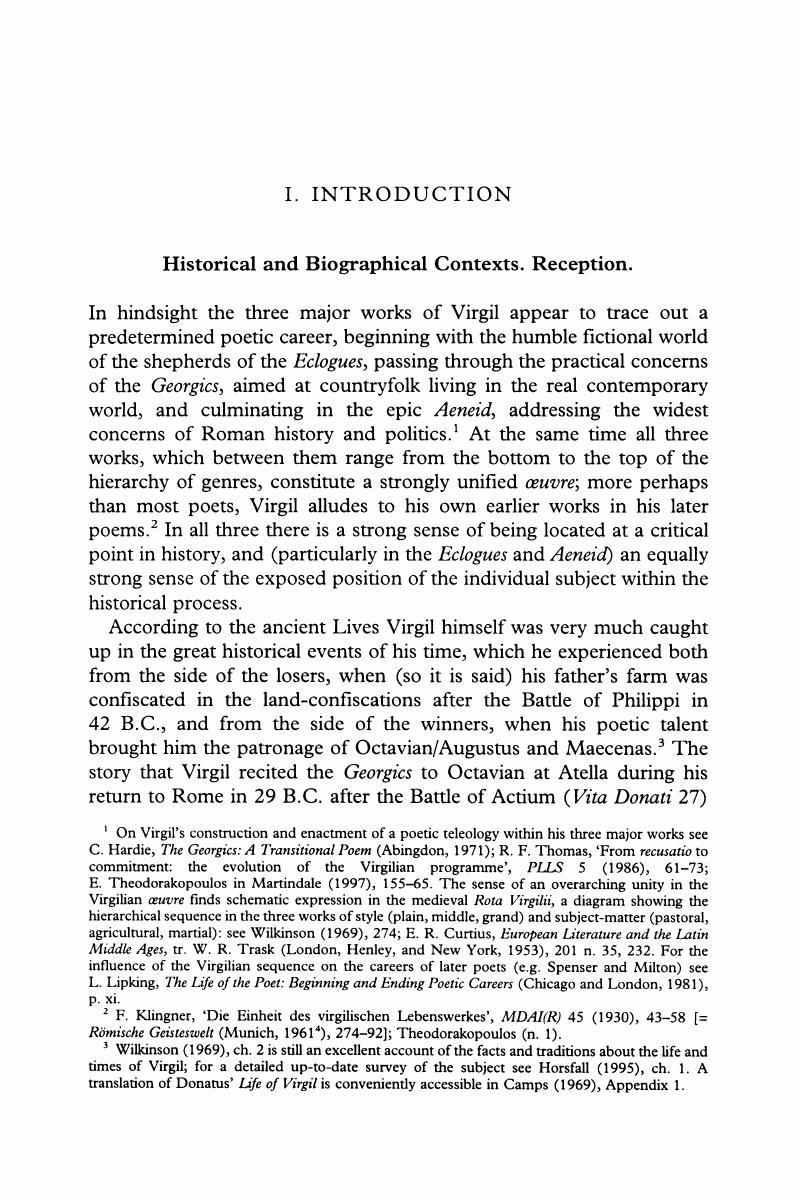No CrossRef data available.
Published online by Cambridge University Press: 05 February 2016

1 On Virgi’s construction and enactment of a poetic teleology within his three major works see Hardie, C., The Georgics: A Transitional Poem (Abingdon, 1971)Google Scholar; Thomas, R. F., ‘From recusatio to commitment: the evolution of the Virgilian programme’, PLLS 5 (1986), 61–73 Google Scholar; E. Theodorakopoulos in Martindale (1997), 155–65. The sense of an overarching unity in the Virgilian æuvre finds schematic expression in the medieval Rota Virgilii a diagram showing the hierarchical sequence in the three works of style (plain, middle, grand) and subject-matter (pastoral, agricultural, martial): see Wilkinson (1969), 274; Curtius, E. R., European Literature and the Latin Middle Ages, tr. Trask, W. R. (London, Henley, and New York, 1953), 201 n. 35, 232 Google Scholar. For the influence of the Virgilian sequence on the careers of later poets (e.g. Spenser and Milton) see Lipking, L., The Life of the Poet: Beginning and Ending Poetic Careers (Chicago and London, 1981), p. xi Google Scholar.
2 Klingner, F., ‘Die Einheit des virgilischen Lebenswerkes’, MDAI(R) 45 (1930), 43–58 Google Scholar [= Römische Geisteswelt (Munich, 19614), 274–92]; Theodorakopoulos (n. 1).
3 Wilkinson (1969), ch. 2 is still an excellent account of the facts and traditions about the life and times of Virgil; for a detailed up-to-date survey of the subject see Horsfall (1995), ch. 1. A translation of Donatus’ life of Virgil is conveniently accessible in Camps (1969), Appendix 1.
4 On which see F. Cox, in Martindale (1997), 327–36.
5 White (1993); Syme (1939).
6 D. Kennedy, rev. Woodman and West (1984), in LCM 9.10 (1984), 157–60; id., ‘“Augustan” and “anti-Augustan”: reflections on terms of reference’, in Powell, A. (ed.), Roman Poetry and Propaganda in the Age of Augustus (London, 1992), 26–58 Google Scholar; Wallace-Hadrill, A., ‘Time for Augustus: Ovid, Augustus and the Fasti ’, in Whitby, , Hardie, , and Whitby, (1987), 221-30Google Scholar.
7 To use the title of the important collection of essays edited by Habinek, T. and Schiesaro, A., The Roman Cultural Revolution (Cambridge, 1997)Google Scholar; the phrase had already been used by Wallace-Hadrill, A. in his review of Zanker (1988), in JRS 79 (1989), 157-64Google Scholar.
8 Recently some scholars have applied to the visual monuments interpretative techniques traditionally at home in literary studies, looking for polysemy and ambiguity: see the (methodologically very different) approaches of Galinsky, G. K., ‘Venus, polysemy, and the Ara Pacis Augustae’, AJA 96 (1992), 457-75CrossRefGoogle Scholar, and Elsner, J., ‘Cult and sculpture: sacrifice in the Ara Pacis Augustae’, JRS 81 (1991), 50–61 Google Scholar. Hardie (1986) also looks for analogies between visual and textual iconographies (e.g. 120–43, 366–9, 379).
9 In general see Martindale, C. A. (ed.), Virgil and his Influence (Bristol, 1984)Google Scholar; the new Cambridge Companion to Virgil (Martindale [1997] ) contains a number of essays on the reception of Virgil. Still unreplaced for the earlier period is Comparetti (1895); on the reception of the Aeneid by first-century A.D. Latin epic poets see Hardie (1993); on the later middle ages see Baswell, C., Virgil in Medieval England. Figuring the Aeneid from the Twelfth Century to Chaucer (Cambridge, 1995)Google Scholar. For the Renaissance: Kallendorf, C., In Praise of Aeneas. Virgil and Epideictic Rhetoric in the Early Italian Renaissance (Hanover and London, 1989)Google Scholar; id., Virgil and the Myth of Venice: The Materiality and Ideology of Reading (Oxford, 1999); Martindale, C., John Milton and the Transformation of the Ancient Epic (London and Sydney, 1986), ch. 3 Google Scholar, ‘Virgil’. For the modern period: Ziolkowski, T., Virgil and the Moderns (Princeton, 1993)Google Scholar.